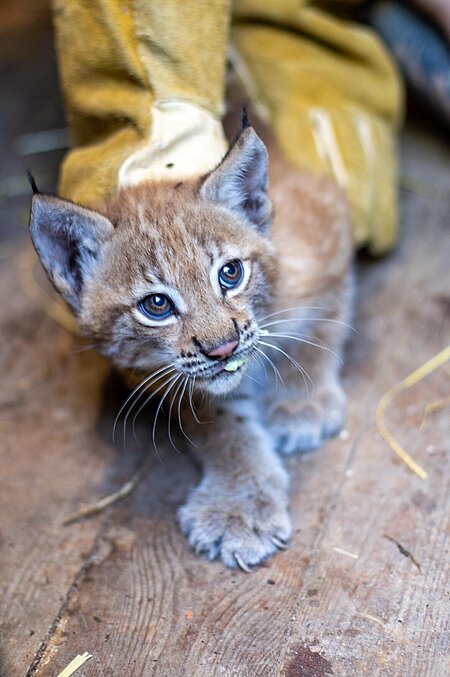![[Translate to English:] [Translate to English:] Luchs-Nachwuchs spielend mit Mutter auf Anlage](/fileadmin/_processed_/2/3/csm_tierpark-hellabrunn-luchs-nachwuchs_c3a5ba72a0.jpeg)
Hellabrunn Zoo is pleased to announce the recent birth of lynx triplets. The little ones, now six weeks old, are doing well.
Born in late April, the trio are the first kittens to arrive in Munich after an eight-year wait. Proud dad Rems, who only moved to Hellabrunn last winter, and mum Mia are getting along harmoniously. The little ones, now six weeks old, are doing well and beginning to explore their enclosure as they grow in confidence. The three lynx kittens have already completed their first two health checks. The veterinarian team confirmed the litter consists of two males and one female, and the weight check showed that all three are healthy, well-fed and quite lively. The animals have also already received their first vaccination and worming treatment. Having spent their first few weeks in the privacy of their next box protected by their parents, the trio have finally emerged and can now often be seen with their mother in the outdoor enclosure.
"We are delighted with the new lynx offspring. It’s Mia’s fourth litter. She is a very experienced mother and takes excellent care of her little ones," said Quirin Linseisen, team leader of the wild cats at Hellabrunn Zoo. "This year all animals born at the zoo will be given names that begin with ‘Y’, so we have now named our three lynx kittens Ylvie, Yuri and Yano."
Verena Dietl, chair of the supervisory board at Hellabrunn Zoo and mayor, is equally thrilled with the adorable triplets: "Every young animal born at Hellabrunn confirms the fantastic work the entire team at the zoo is doing day after day. And when it happens to be an endangered species, this represents an important contribution to species and nature conservation."
Apart from the European wildcat and a handful of surviving leopards in the Caucasus, lynx are the largest and only other wild cat native to Europe. Due to their vast distribution area, they are not officially listed as endangered. However, in the past, lynx were almost wiped out in many regions. In Germany, for example, the lynx was considered extinct until the late 20th century. This was largely due to human persecution through hunting and the destruction of habitats. Conservation efforts have since contributed to an upgrade in status and there are now reintroduction projects all over Europe. In Germany, around 200 lynx currently live in the Bavarian Forest, Palatinate Forest and the Harz Mountains. The lynx residing at Hellabrunn Zoo are a subspecies of the Eurasian lynx called the northern lynx. Their distribution area is located in the British Isles and Northern Europe. Reintroduction projects are also being planned here.
Hellabrunn Zoo has been participating in the conservation breeding programme for the Eurasian lynx for many years. "After eight years, it is wonderful that we now have lynx offspring in Hellabrunn again," said zoo director Rasem Baban. "With this ex-situ conservation programme, we are making a significant contribution to the preservation of this rare species."
